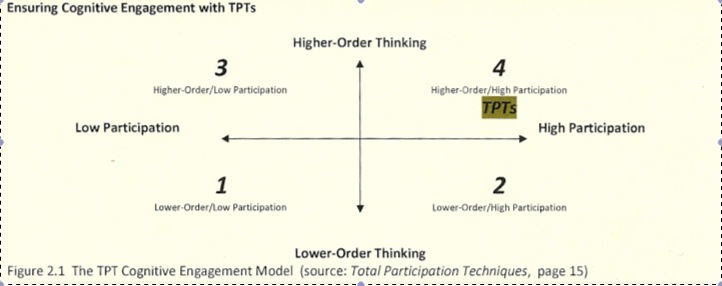
At last month’s ASCD conference, I had the pleasure of speaking with William and Persida Himmele, the husband and wife team who wrote the wonderful new book Total Participation Techniques: Making Every Student an Active Learner. I can’t say enough good things about how useful and practical this book is, and I’m excited to share it with you.
I asked the Himmeles what they think the big take-away for teachers should be when they read this book. Persida explained that the goal is not just getting all students to participate in lessons, but getting them to participate in ways that are meaningful, authentic, and involve higher order thinking.
Often, teachers are tempted to settle for less. Sometimes the issue is misplaced empathy, a concept the Himmeles explore more fully in their first book, The Language-Rich Classroom: A Research-Based Framework for Teaching English Language Learners. As educators, we tend to let students (especially English language learners and kids with special needs) get away with one word responses and don’t press them to move into the realm of critical thinking.
Oh, how I have been guilty of that! I’ll call on a struggling student who tells me the basic answer and then ask a higher achieving child to explain why it’s the correct answer so that I don’t embarrass the struggling student or put him or her on the spot. Persida explains that this is a bias discrimination you can see: teachers have good intentions, and misplaced empathy looks nice, but it does a huge disservice to struggling kids. A big cause of the achievement gap is that so many kids are allowed to linger in quadrant one of the figure below. Persida urges us to be tenacious and decide we’re not going to allow students not to learn. We have to challenge our students and convey an attitude of “I am not going to let you fail or stay where you’re at right now.”
The Himmeles shared a story about their daughter, who once came home from school and said she was bad at math. Instead of telling her, “Oh, honey, that’s okay, you’re good at other things,” they said to her, “Okay, so get good at it!” They persisted through the struggle with her and she’s now at the 95th percentile in math. William explains that kids get it in their heads that they’re not going to get master a skill or subject area because they’re not smart. “Smartness doesn’t impress me,” he says. The person who is going to do well is the person who is using the right strategy at the right time. He cautions teachers not to tell kids they are smart, and instead ask, “What did you do to figure it out? What strategies did you use?” and build from that point.
The Himmeles wanted to be very clear: they’re not blaming teachers. They understand that the system of school does not support teachers in pursuing higher-level thinking and total participation in the classroom. Persida talked about how NCLB measures without providing supports and pathways. The testing pressure takes away time for kids to process information. And as educators, we often have no choice but to keep kids stuck in lower level thinking and minimal involvement because we have to hurry. The Himmele’s book works from the assumption that we have to trust the teachers and the kids.

And that’s the beauty of this book: it clearly explains 37 different classroom-ready techniques teachers can use to teach the curriculum they’re required to teach, but in ways that get kids actively involved on a deeper level than just a class discussion. Some of the ideas require advance planning and others which can be done on the spur of the moment once they’ve been added to your teaching repetoire.
They suggest creating a Total Participation Techniques (TPTs) folder for each child to keep in their desks so the techniques can be used any time. The materials can be laminated and re-used from year to year. Some of the items include a laminated piece of consutrction paper (to use as an individual whiteboard), true/not true hold up cards, number cards, a processing card to show where students are in their thinking (shown on the book cover), and guided note-taking templates.
William explained that Total Participation Techniques help with classroom management because kids are allowed to talk and move around. It also enhances the sense of community, which is the foundation for a well-run classroom. If you have the same 5 kids answering questions over and over, using TPTs will get the other students used to interacting and working collaboratively and get your entire class more actively involved in their learning. I love this quote from page 109 of the book: “The best thing about implementing TPTs is that teaching is no longer a guessing game as to who is experiencing growth. With TPTs, you get to observe growth as it happens. You get to celebrate learning right alongside your students.”

Angela Watson
Founder and Writer
Sign up to get new Truth for Teachers articles in your inbox
OR

Join our
community
of educators
If you are a teacher who is interested in contributing to the Truth for Teachers website, please click here for more information.















